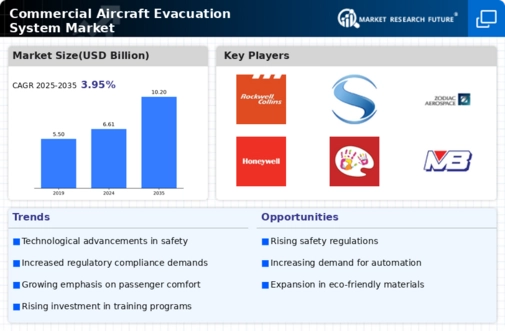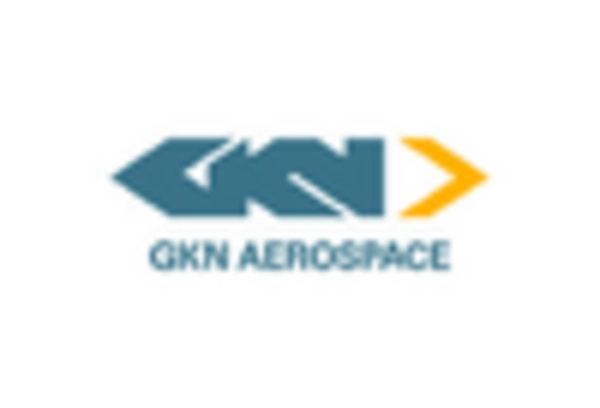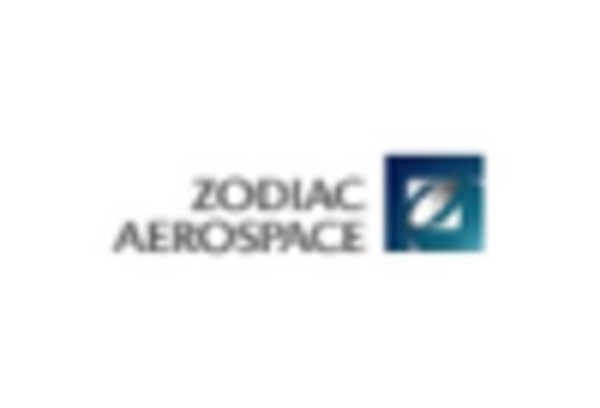Regulatory Standards and Compliance
Regulatory standards play a crucial role in shaping the Commercial Aircraft Evacuation System Market. Authorities such as the Federal Aviation Administration (FAA) and the European Union Aviation Safety Agency (EASA) impose stringent regulations regarding evacuation system performance and reliability. Compliance with these regulations is not only mandatory but also influences market dynamics, as manufacturers strive to meet or exceed these standards. The increasing frequency of audits and inspections by regulatory bodies may drive innovation and improvements in evacuation systems. Consequently, companies that proactively adapt to evolving regulations may gain a competitive edge, thereby impacting market growth.
Increased Air Traffic and Fleet Expansion
The Commercial Aircraft Evacuation System Market is significantly influenced by the increase in air traffic and the expansion of airline fleets. As more airlines enter the market and existing carriers expand their operations, the demand for new aircraft equipped with state-of-the-art evacuation systems rises. The International Air Transport Association (IATA) forecasts a steady increase in passenger numbers, which necessitates the acquisition of additional aircraft. This trend is likely to drive the demand for advanced evacuation systems, as airlines seek to comply with safety regulations and enhance operational efficiency. Consequently, manufacturers may experience increased orders for evacuation systems, contributing to market growth.
Growing Demand for Enhanced Passenger Safety
The emphasis on passenger safety is a primary driver in the Commercial Aircraft Evacuation System Market. Airlines are increasingly aware of the need to ensure the safety of their passengers during emergencies, leading to heightened investments in evacuation systems. According to industry reports, the market for evacuation systems is projected to grow at a compound annual growth rate (CAGR) of approximately 5% over the next five years. This growth is attributed to the rising number of air travelers and the corresponding need for effective evacuation solutions. Airlines that prioritize passenger safety are likely to enhance their brand reputation, which may further stimulate demand for advanced evacuation systems.
Technological Innovations in Safety Equipment
The Commercial Aircraft Evacuation System Market is experiencing a surge in technological innovations aimed at enhancing safety equipment. Advanced materials and designs are being integrated into evacuation slides and rafts, improving their durability and efficiency. For instance, the introduction of lightweight composite materials has led to a reduction in the overall weight of evacuation systems, which can enhance aircraft performance. Furthermore, the incorporation of smart technologies, such as automated deployment systems, is likely to streamline evacuation processes. As airlines and manufacturers prioritize safety, investments in research and development are expected to rise, potentially leading to a more competitive market landscape.
Focus on Sustainability and Eco-Friendly Solutions
Sustainability is becoming an essential consideration in the Commercial Aircraft Evacuation System Market. As environmental concerns grow, manufacturers are exploring eco-friendly materials and processes for producing evacuation systems. The shift towards sustainable practices is not only driven by regulatory pressures but also by consumer preferences for environmentally responsible products. Airlines are increasingly seeking to reduce their carbon footprint, which may lead to the adoption of more sustainable evacuation solutions. This focus on sustainability could potentially reshape the market landscape, as companies that innovate in this area may attract environmentally conscious airlines and passengers, thereby enhancing their market position.


















Leave a Comment